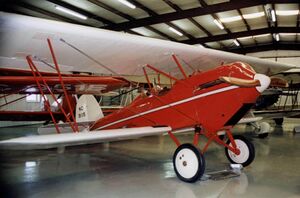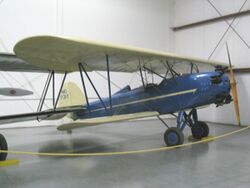Engineering:Brunner-Winkle Bird
The Brunner-Winkle Bird was a three-seat taxi and joy-riding aircraft produced in the US from 1928 to 1931.
Design and operation
The Model A version was powered by the ubiquitous Curtiss OX-5, and featured a welded steel-tube truss fuselage with metal and fabric skinning. The wings, constructed of Spruce and plywood were also covered with metal and fabric skinning. The Model A had a reasonable performance for an OX-5 powered aircraft. The Model A's ease of handling led to its entry into the 1929 Guggenheim Safety Airplane contest, where it was awarded the highest ratings for a standard production aircraft.[1]
The Model A was awarded Group 2 approval no 2-33 in January 1929 for the first nine aircraft serial no. 1000 to 1008. Aircraft serial no. 1009 upwards were manufactured under Air Transport Certificate no. 101.[2][1]
The Model B followed on from the initial Bird design and was fitted with the uncowled Kinner radial engine. Production aircraft were designated BK.[1]
Variants
Data from: aerofiles.com[3]
- Model A
- original production version with Curtiss OX-5 engine (ca. 80 built)
- Model AT
- version with Milwaukee Tank engine (2 converted from Model A)
- Model B
- version with Kinner K-5 engine (1 prototype)
- Model BK
- production version of Model B (84 built)
- Model C
- version with Wright J-5 engine (1 built)
- Model CC
- version with Curtiss R-600 Challenger engine (1 built)
- Model CJ
- version with Jacobs LA-1 engine (6 built)
- Model CK
- version with Kinner B-5 engine (50 built)
- Model RK
- export version of Model CK (1 built)
- Model E
- 4-5 seat version with enclosed cabin and Kinner B-5 engine (1 built)
- Model F
- version with Packard DR-980 (1 built)
Specifications (Bird Model A)
Data from U.S. civil aircraft series:Vol.2 [2]
General characteristics
- Crew: 1
- Capacity: 2 passengers
- Length: 22 ft 3 in (6.78 m)
- Wingspan: 34 ft 00 in (10.36 m)
- Height: 8 ft 8 in (2.64 m)
- Wing area: 266 sq ft (24.7 m2)
- Empty weight: 1,315 lb (596 kg)
- Gross weight: 2,150 lb (975 kg)
- Powerplant: 1 × Curtiss OX-5 V-8 water-cooled piston engine, 90 hp (67 kW)
- Propellers: 2-bladed wooden fixed-pitch propeller
Performance
- Maximum speed: 105 mph (169 km/h, 91 kn)
- Cruise speed: 88 mph (142 km/h, 76 kn)
- Range: 450 mi (720 km, 390 nmi)
- Service ceiling: 12,500 ft (3,800 m)
- Rate of climb: 520 ft/min (2.6 m/s)
See also
Aircraft of comparable role, configuration and era
(Partial listing, only covers most numerous types)
- Alexander Eaglerock
- American Eagle A-101
- Buhl-Verville CA-3 Airster
- Butler Blackhawk
- Command-Aire 3C3
- Parks P-1
- Pitcairn Mailwing
- Spartan C3
- Stearman C2 and C3
- Swallow New Swallow
- Travel Air 2000 and 4000
- Waco 10
Related lists
References
Citations
- ↑ 1.0 1.1 1.2 John, Talmage. "The Brunner Winkle Bird at the Cradle of Aviation Museum". http://www.cradleofaviation.org/history/history/aircraft/brunner_winkle_bird.html. Retrieved 21 September 2018.
- ↑ 2.0 2.1 Juptner, Joseph J. (1 May 1993). U.S. civil aircraft series:Vol.2. TAB AERO. p. 9. ISBN 978-0830643677. https://archive.org/details/uscivilaircraft0002jupt.
- ↑ "Aircraft Ba-Bl". aerofiles.com. http://aerofiles.com/_ba.html. Retrieved 2008-10-19.
Bibliography
- "Yanks Air Museum". https://yanksair.org/collection/brunner-winkle-bird-bk/. Retrieved 22 December 2019.
- Photos of Brunner-Winkle Bird
 |



